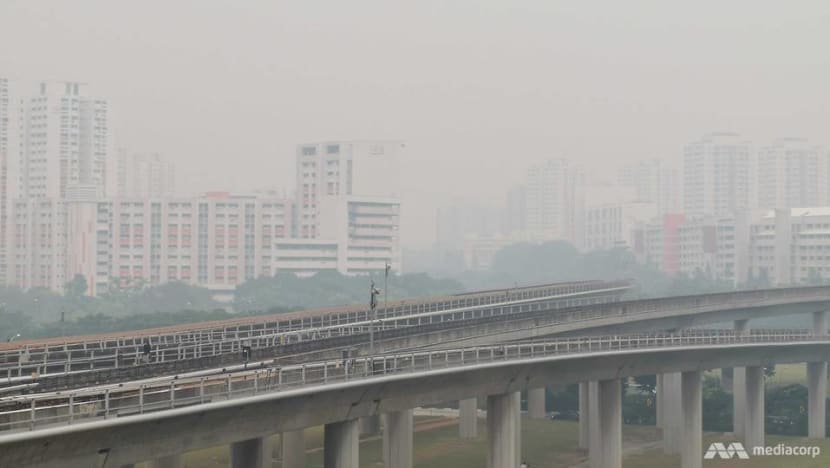Medium risk of haze returning to Southeast Asia, unlikely to be as severe as previous major incidents: SIIA

HDB blocks in Jurong East shrouded in haze on Sep 14, 2019. (Photo: Kevin Kwang)
SINGAPORE: Haze could return to Southeast Asia this year, although it is unlikely to reach the extent seen in previous major haze incidents, according to a report released by the Singapore Institute of International Affairs (SIIA) on Tuesday (Jun 28).
On a risk scale of Green (low), Amber (medium), and Red (high), SIIA’s latest report rated the risk of transboundary haze this year as Amber.
“While it is probable that the region will experience some haze pollution, it is unlikely to be on the same degree as transboundary haze incidents in 1997-1998, 2013, 2015, and 2019,” the 24-page report said.
This is partly due to weather conditions. The region is likely to see normal or wetter-than-average rainfall in the coming months, meaning the dry season will be relatively mild, which will help to keep any haze under control.
While high commodity prices should result in some new plantation expansion and land clearing, the report said the scale of land clearing is not projected to be as extreme as previous years.
The latest assessment is more cautionary compared to last year, which was colour-coded green.
In 2021, Indonesia experienced a low number of fire alerts, with 364 high-confidence fire alerts recorded by NASA’s Fire Information for Resource Management System in September, which is the peak of the dry season.
This is lower compared to the 427 and 8,698 hotspots recorded by satellites for the same months in 2020 and 2019 respectively.
In a foreword to the report, SIIA’s chairman Simon Tay said the shift in colour and SIIA’s assessment does not reflect a “weakening” of sustainability policy in Indonesia and the region.
Instead, the caution arises from an increasing tension between market forces and climate action in sectors that impact the risk of haze, he said.
SIIA’s risk assessment is based on three factors - weather (projected rainfall and temperature), people (human behaviour), and policies (climate and land management directions).
Based on weather factors alone, the report said there is no elevated risk of haze.
But current record high palm oil and other forest commodity prices may drive growers to expand or intensify their plantation operations with land clearing through the illegal use of fire.
Palm oil prices have hit unprecedented levels this year amid a commodity price boom, further exacerbated by the Russia-Ukraine war impacting vegetable oil supply.
According to the report, the benchmark Malaysia futures monthly price for crude palm oil soared in the first half of 2022, at one point exceeding RM8,540 (US$1,940) per tonne.
Meanwhile, oil palm growers bought double the amount of oil palm seeds compared to 2018, when palm oil prices were at a historic low.
These trends suggest that there will be more planting of oil palm in the near term, increasing the risk of haze if fire is used to open up new land for planting or to prepare land for replanting, the report said.
While the Indonesian government has implemented numerous policies aimed at lowering the risk of fires - including a permanent moratorium on the granting of new concession permits in primary forest and peatland areas - the sharp rise in palm oil prices may have a potential impact on land clearance and planting by growers.
Unless closely and strictly policed, the report said some may resort to the illegal use of fire for land clearing, and may illegally encroach on forest and peatland areas, in order to maximise profit.
In addition, there is also controversy surrounding the policy response to the rise in palm oil prices, which includes a ban on palm oil exports in late April and May to bring down domestic palm oil prices and alleviate inflation in food prices and cooking oil shortages.
The report said that experts it had interviewed agreed that these policies are unlikely to dampen planting activities as the global factors that are driving high palm oil prices are still in effect.
Looking beyond 2022, the report noted that there are other factors that may potentially affect the risk of haze in future years.
“The present situation of record high food and commodity prices underscores the fact that food security remains paramount,” it said.
“There will be increased pressure for countries to not only create carbon projects, but also rice paddies,” it added.
With Indonesia heading into general election and presidential election in 2024, the political landscape in Southeast Asia’s largest economy is expected to become increasingly complex in the coming months.
“That said, with climate action having entered the mainstream, it is likely that any future Indonesian government will continue to include sustainability among their priorities,” the report said.
At the 9th Singapore Dialogue on Sustainable World Resources on Monday, Sustainability and the Environment Minister Grace Fu said ASEAN must continue addressing recurring challenges such as haze.
She expressed Singapore’s appreciation of Indonesia’s efforts and commitment to preventing fires.
“Should hotspots escalate, Singapore stands ready to support and assist Indonesia as we did during the international fire-fighting efforts in 2015,” said Ms Fu.















